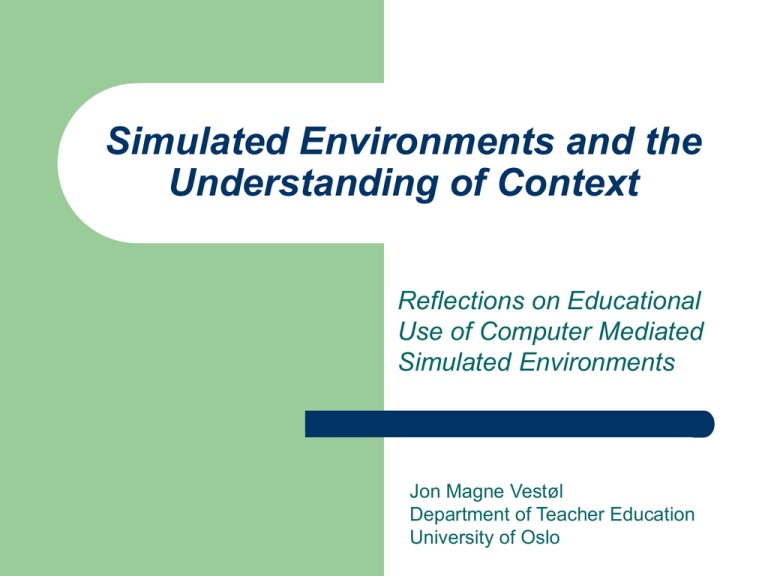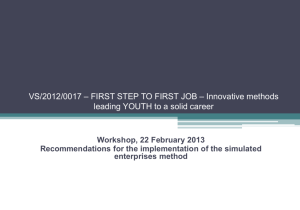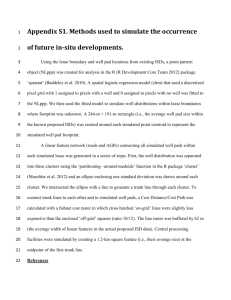Simulated Environments and the Understanding of Context Reflections on Educational
advertisement

Simulated Environments and the Understanding of Context Reflections on Educational Use of Computer Mediated Simulated Environments Jon Magne Vestøl Department of Teacher Education University of Oslo Purpose of the presentation Examine the understanding of computer based simulated environments as educational means Reflections represent by-products of a newly completed thesis in the field of moral education. I will refer to some computer mediated student tasks from the research project The main question What happens to our (sociocultural) understanding of context and situated action when students are dealing (individually or collectively) with simulated tasks and interacting with simulated persons online? The question has relevance both to educational practice and educational research What I intend to do 1. 2. 3. I will compare a text based and a computer based simulation to examine the nature of computer simulation as an educational mean I will shortly examine the contextual aspects that are activated when students work with computer mediated simulated cases I will shortly examine possible expansions of context when students work within computer simulated environments 1a. Text based simulation A student task from a Norwegian text-book of moral education: ”Ida is eighteen years old. She has recently started her third year of secondary education and is pregnant. Knut, the father of the child, wants her to have an abortion, to make her able to fulfill her education. What would you advice Ida to do, and what kind of arguments would you use?” 1b. Computer based simulation Eastern European woman with a severely ill child Seriously considers working for the mafia to finance necessary but expensive medical treatment for the child Students are asked to give her their advice Case 3: Woman asking for advice. 1c. Comparison: text - computer Similarities Rational nature of the tasks Students’ role as advisors Establishment of imaginary context (”virtual”, simulated). Computer add-ons Direct communication (student to person). Role of technical and mediational interface (chat – news agency) cfr Bolter & Grusin: Remediation The remediated nature of the simulated and virtual 2. Simulated environments and the sociocultural concept of context Roger Säljö on the concept of context Physical Historical Mental Communicative (Säljö: Lärande i praktiken pp 135-136) Individual simulated tasks as exaggerations of mental and communicative context (physical diminished) Group based simulated tasks as (integrated or just added?) activations of mental/comm. and physical contexts? 3a. Expansions of context Roger Säljö: The problem of tool “transfer” between decontextualizing and contextualizing fields of practice (school versus work/daily life) (Säljö: Lärande i praktiken, p 154) 3b. Expanded simulated context? Bypassing woman addressing victim in a contemptuous way Students writing directly to the woman, using emotionally colored verbal tools Case 2: Woman bypassing victim 3c. Students’ use of verbal tools Emotional tools YOU ASSHOLE! Damned idiot! You’re disgusting! Selfish woman! Shame on you! Pull yourself together! You make me sick! What an awful being you are!!!!!!! Norm tools The Golden Rule The act of reciprocity Human worth The duty to help Charity Combined use of emotional tools and norm tools 3d. Expanded contextual field? Students are expanding the limits of accepted tool activation within school Students seem to activate verbal tools that are consumed, mastered and appropriated in fields of practice outside school Does this indicate that computer mediated case based tasks can serve as means for expanding mental and communicative contextual limitations of ”schooling”? Conclusions Computer mediated case tasks partially remediate traditional text based simulations Computer mediated case tasks exaggerate the mental and communicative contextual dimensions Computer mediated case tasks may possibly be able to expand contextual dimensions crossing borders between academic and non academic fields of practice Possible implications for teacher education (TE) Concerning the “transfer” of tools. Should the ”transfer” of tools be addressed more frequently and specifically in TE to stimulate the search for educational means that may expand contexts and strengthen the relationship between ”schooling” and ”real life”? Concerning use of computer based cases in TE. Should such cases try to exaggerate non-rational aspects of communication e. g. between student teacher and simulated student to trigger contextual expansions and activate zones of “transfer”?




